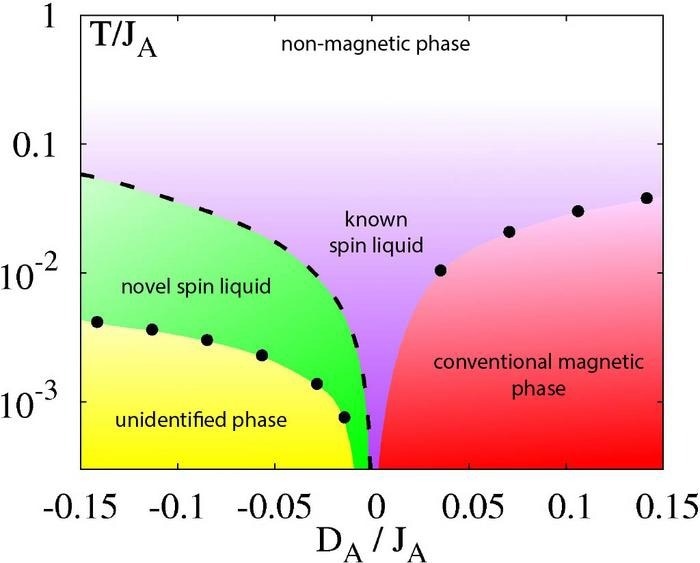Researchers from Okinawa Institute of Science and Technology outline a strategy for using machine learning (ML) to address challenging condensed matter physics problems in a study published in Physical Review Research.

Phase diagram showing the different properties of pyrochlore at different temperatures. In green is the spin liquid phase described in 2020; in yellow, the mystery phase that the researchers were unable to identify in previous simulations. Image Credit: Sadoune et al., 2025
There’s often a lack of data at the forefront of research, especially when tackling complex scientific questions. In contrast, large, high-quality data sets are typically needed for training in order for machine learning (ML) to be successful.
The team's approach addresses challenging issues that were previously unresolvable by ML algorithms alone or by physicist simulations.
The frustrated magnets (magnetic materials whose conflicting interactions result in unusual magnetic properties) were at the core of the study. Research on these materials has improved our knowledge of quantum gravity and advanced our understanding of quantum computing. However, due to the limitations imposed by the interaction of magnetic ions, it is extremely challenging to model frustrated magnets.
The researchers from Japan, France, and Germany were interested in how the characteristics of a certain type of magnetic material change when it cools to absolute zero. Their attention was drawn to a specific phase known as a "spin liquid": just as liquid water freezes into ice, this spin liquid freezes into a distinct type of magnetic state. However, when it came to identifying that state, they were unable to interpret the findings of their simulations.
Recently, physicists have been excited about a type of quantum spin liquid which could help us to understand fault-tolerant quantum computers, In 2020 we realized that this spin liquid could occur naturally in a class of magnetic materials called ‘breathing pyroclores’. But we couldn’t figure out what happened to that spin liquid at low temperatures.
Nic Shannon, Study Co-Author, Professor and Head, Theory of Quantum Matter Unit, Okinawa Institute of Science and Technology
The OIST researchers collaborated with ML specialists from LMU Munich, who had created an ML system capable of classifying conventional magnetic orders.
Our method is highly interpretable, meaning it’s easy for humans to decipher the decision-making processes, and doesn’t rely on prior training of the model. This makes it better suited for such applications where data is limited, compared to other forms of machine learning, Before we teamed up with OIST, we had never applied it to a spin liquid, so were excited to see if it could be useful in gaining insights into such difficult physics problems where all other approaches had failed.
Lode Pollet, Study Co-Author and Professor, Ludwig Maximilian University of Munich
The researchers employed Monte Carlo simulation, a computer approach, to model their spin liquid cooling. By putting their simulation data through the ML algorithm and evaluating the results, the researchers were able to identify patterns within the ML output.
They were able to utilize these findings to perform Monte Carlo simulations in reverse, seeding simulations at low temperatures with the patterns discovered by ML and heating the previously unknown phase to model the transition in the other manner. These new simulations validated the features of this phase, providing fresh insights into this field of quantum study.
What was interesting is that neither man nor machine alone were able to solve this problem—it was more like colleagues collaborating, with the algorithm spotting something we hadn’t, and vice versa, building together towards this complete picture of understanding. It’s exciting because there are many more complex problems to solve within condensed matter physics, which we may be able to achieve through such a combined human and AI approach.
Dr. Ludovic Jaubert, Researcher, University of Bordeaux
Journal Reference:
Sadoune, N., et al. (2025) Human-machine collaboration: Ordering mechanism of rank-2 spin liquid on breathing pyrochlore lattice. Physical Review Research. doi.org/10.1103/c6z1-wh6l.